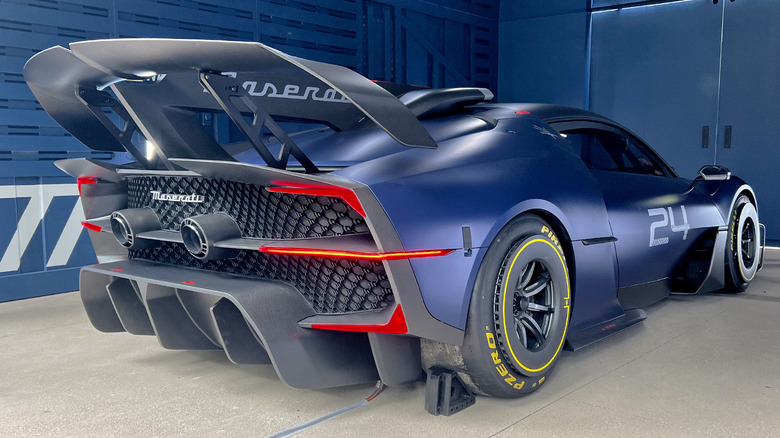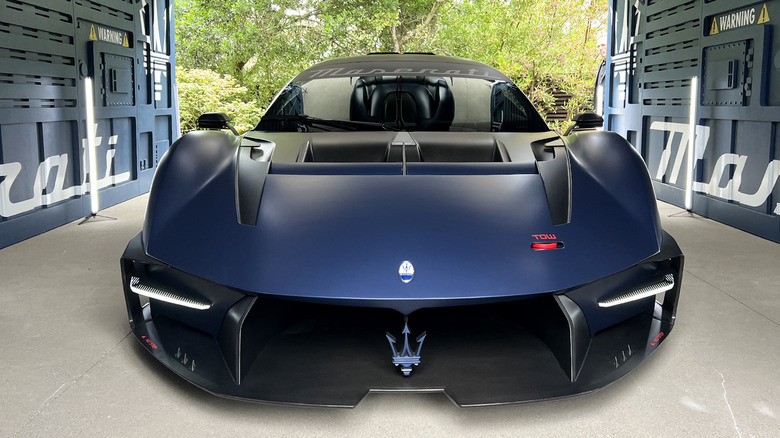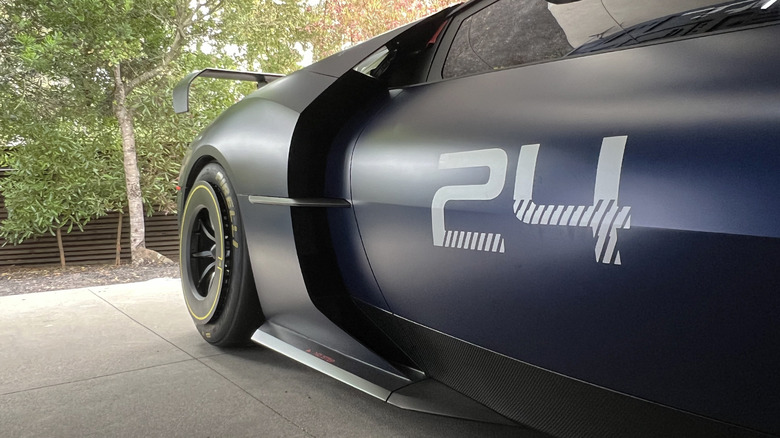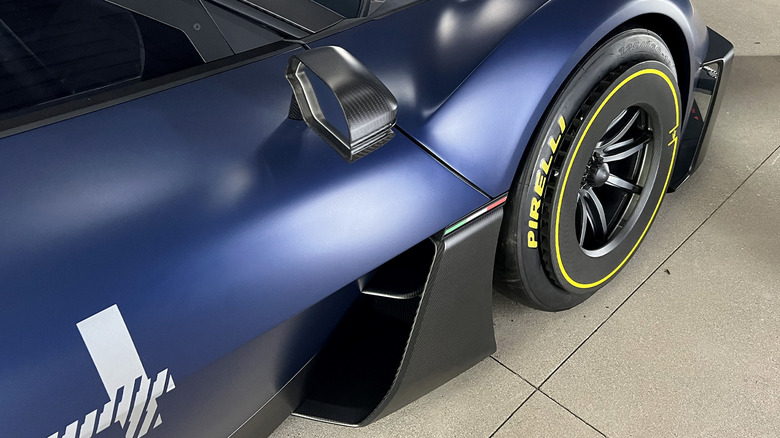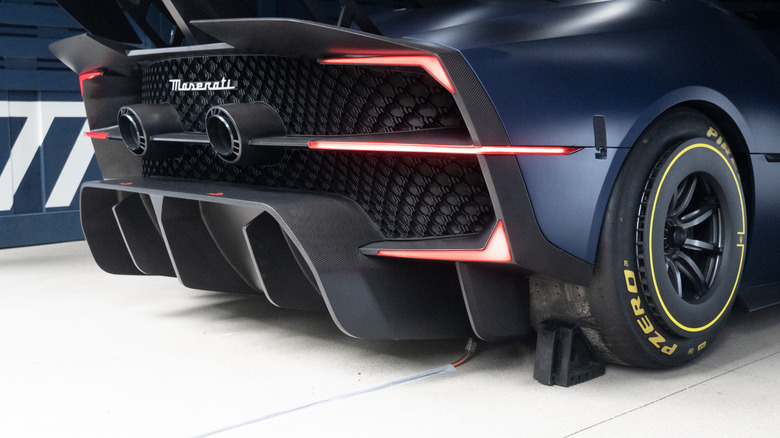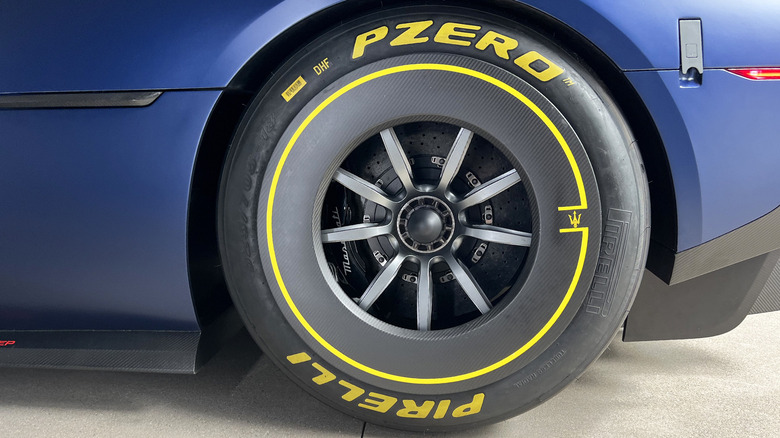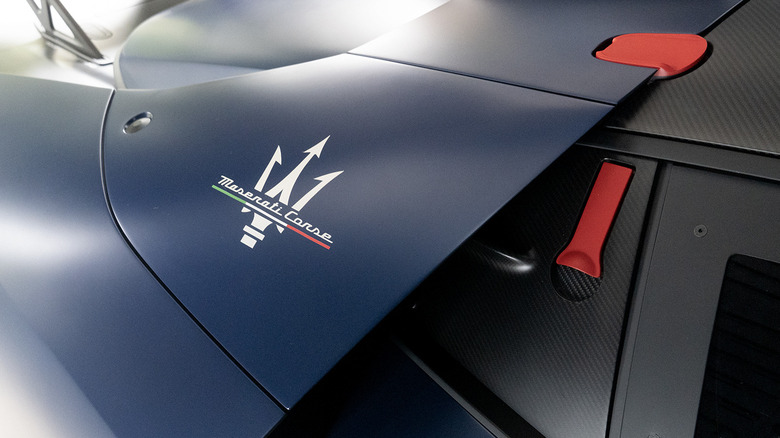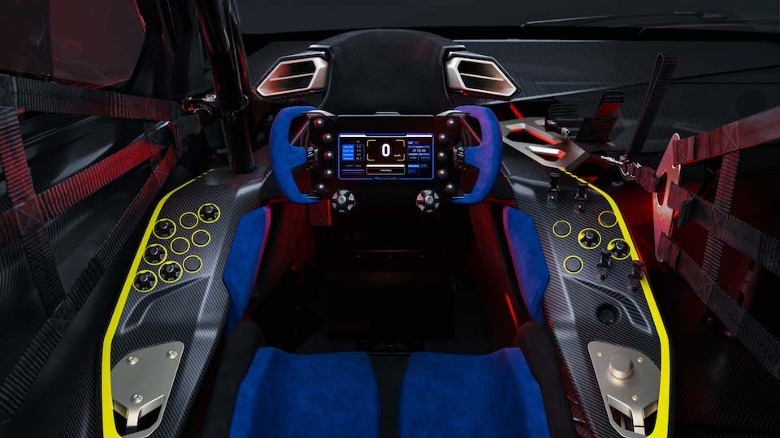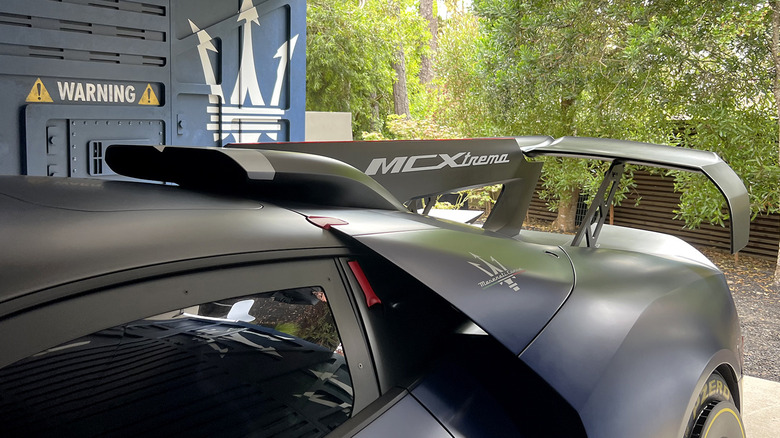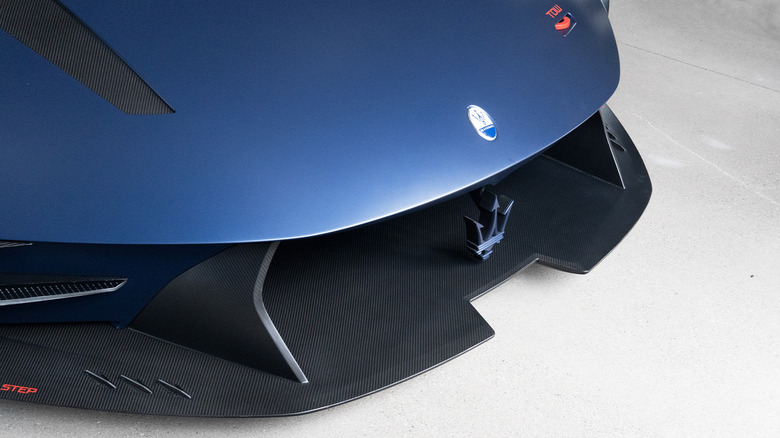Exclusive First Look: Maserati's New MCXtrema Track-Only Hypercar
Today at Monterey Car Week's The Quail, A Motorsports Gathering, Maserati finally pulled the wrapping paper off the highly anticipated MC20 supercar's track-only variant, long known only as "Project 24." Now officially dubbed the MCXtrema, Maserati's dedicated track toy steps up into the realm of hypercars with the "Nettuno" twin-turbocharged V6 turned up to 730 horsepower, plus all the aero componentry and suspension revisions to fully dial in the massive performance potential that the MC20 chassis always promised.
Ahead of the official debut, I spoke with Maserati Head of Design Klaus Busse and Vehicle Dynamics Performance Leader Giulio Crocioli about how the MCXtrema will help propel the future of internal-combustion power in an age when every Maserati model, including the roadgoing MC20, will soon feature fully electric drivetrains.
Even more radical racecar design
The MCXtrema builds upon the hardcore nature of the MC20 GT2 that Maserati unveiled earlier this year, with more aerodynamic elements producing more downforce. At first glance, the splitter, diffuser, skirts, wing, and dorsal stabilizar fin all stand out as serious departures from the street-legal MC20. But massive side intakes with flying buttresses over to the carbon-fiber roof also create a more muscular shape that clearly reveals the MC20 has traveled far beyond anything that might ever drive on public roads.
"We wanted to really make that statement beyond the GT2 that we had launched earlier this year," Busse told me. "To also give a very special few customers the opportunity to take a Maserati onto the racetrack with a dedicated machine."
For Busse, all the design elements that helped to reestablish Maserati's historical style and performance on the trio of new road cars—MC20, Grecale, and GranTurismo—still appear on the MCXtrema to a certain extent.
"It all starts in the front with the trident," Busse said. "It's not just the logo, it's the weapon of a mythical god, it's Neptune's weapon. So that's the trophy that you carry on this car. And basically from that point, you have this central fuselage that goes all the way back to our first Formula racers from pre-war, all the way up to the early fifties where you basically had the central fuselage without the wheels. And then of course, when you start to cover the wheels, you add these amazing sculptural elements."
The edge where design meets performance
Some of the street-legal MC20's forms, especially the nose, front fenders, and roofline, still shine through. But history takes a modern turn when the demands of track performance come to the fore.
"Our road cars, like the GranTurismo and the MC20, those cars are all designed with the urban environment in mind, to be respectful in the place where they go, to be a rolling sculpture. With this car, the natural habitat is the racetrack," Busse points out. "So in that sense, the gloves are off and we can purely focus on creating a statement in terms of innovation and functionality."
But make no mistake, the few customers who might want to take such a radical car out on public roads would quickly regret their decision. The whole MCXtrema now measures 5,199 millimeters long—just over 17 feet, or nearly 20 inches longer than an MC20. At the first tiny crack in the road or speed bump, the long carbon fiber overhangs front and rear will scrape and tear. Top speed on the smooth tarmac of well-maintained tracks is the name of the game here—as the dorsal stabilizer suggests.
"This fin is more for high-speed tracks," Busse admitted. "So if you go on Laguna Seca, you will not feel the impact of this fin, but if you go on a high-speed track like Le Mans, it'll give you this kind of stability. But also for us, it was an important statement just to celebrate the radical approach to this car."
Whether Maserati might actually take an MCXtrema, in addition to the GT2, out for a 24-hour race at Le Mans remains a mystery. Theoretically, a customer could enter as a privateer, too, because Maserati's engineers focused on legal homologation of all the upgrades that make the MCXtrema so hardcore.
Powering up the Nettuno V6
First and foremost, the "Nettuno" engine that first debuted on the MC20 before appearing in detuned state for both the Grecale SUV and GranTurismo four seater's Trofeo trims now gets a big upgrade. Output bumps up from 621 horsepower in the MC20 Coupe and Spyder to 730 horses, with torque rated at 538 lb-ft.
"Here we have an evolution of the Nettuno that we use on the MC20 road car," Crocioli explained. "In this case, we reach the incredible power of 730 horsepower. So more than 100 horsepower more... To do this, we do some modification on the engine, in particular to the turbos, intake, exhaust, and electronics."
The Nettuno already produces an intensely unique experience when mounted just behind the cockpit of the MC20—not to mention allowing for impressive performance even when dulled down for the more traditional application in the Grecale and GranTurismo. The sounds of whooshing turbos as boost builds and blowoff valves and exhaust almost make the spellbinding acceleration an afterthought. And yet, the Nettuno's F1-derived pre-chamber combustion and twin spark plug system puts out so much punch that a rating of 621 horsepower for the roadgoing MC20 almost seems a bit understated.
Now imagine over 100 horsepower more, made possible by a Bosch Motorsport 6.4 EVO engine control unit, new turbos, with a dual-tipped race exhaust system (which does use catalytic converters), and Maserati's in-house traction control program helping to put that grunt to the ground. A six-speed sequential gearbox and limited-slip differential should help acceleration coming out of corners, given that max torque arrives at only 3,000 RPM.
Differences from the roadgoing MC20
Knowing that the roadgoing Cielo chassis featured a slightly revised carbon-fiber structure than the MC20 Coupe, I also asked Crocioli about the MCXtrema's monocoque. Where the Cielo needed a bit more reinforcement because it lacks a roof, and therefore would have lost some rigidity, the MCXtrema can actually use the Coupe's layup because it adds a roll cage.
"What we share is also the carbon-fiber monocoque," Carcioni said. "In this case, we of course added the roll cage, both for safety reasons but also to increase the stiffness of the monocoque. Then we have aluminum front and rear subframes and double-wishbone suspension that are developed for this specific application."
Even with the roll cage and extra aero components, the MCXtrema still tips the scales at just shy of 2,900 pounds—or around 400 less than an MC20 coupe and 550 less than a Cielo, both of which feel far lighter than their weights on paper might suggest. But Crocioli's description of the MCXtrema's revised suspension only begins to hint at the changes beneath such striking skin.
All the expected track goodies
Maserati ensured that all the MCXtrema's suspension revisions live up to homologation regulations so that customers can truly race in sanctioned series, rather than just taking part in private track days. And though the show car that debuted at The Quail made checking out the suspension (and interior) nearly impossible, Crocioli showed me some images from the development process. Billet aluminum wishbones snake around extensively adjustable components, from the four-way manually adjustable Öhlins coilovers to three-point-adjustable anti-roll bars. Even the bushings can be tuned to dial in dive and lift, in addition to the three bolt positions for the enormous rear wing.
Getting that suspension perfect will no doubt make the Nettuno's dry-sump lubrication absolutely necessary during high-g cornering. During pit stops, air jacks lift the car up—no front-axle lift system, which I loved so much while driving both the MC20 Coupe and Cielo (and just about every lowslung supercar with splitters I worried about dinging).
Those wheels measure 18 inches in diameter, with centerlocks instead of the road cars' five lugs nuts. And not too surprisingly, carbon brakes behind the aero discs will differ from the road car units. But maybe the biggest surprise I noticed on the show car, and asked Crocioli to confirm, was that the wheels wear 325-millimeter Pirelli racing slicks at all four corners, rather than a staggered setup with wider tires out back. Crocioli seemed confident that the MCXtrema's supreme aero and weight balance makes a square setup the right choice.
Safety and driver control systems
The show car Maserati brought to Monterey also lacked a real interior, but Crocioli again pulled out his laptop to show me a few renderings of the planned cabin. First thing I noticed? Steering wheel-mounted paddle shifters, rather than the column-mounted paddles on the roadgoing MC20 (which I consistently missed while trying to bang through gears going into and coming out of corners). But the steering wheel also houses a five-inch display in the center, with buttons for radio and drive settings a la F1 cars, as well as two knobs for adjusting traction control and ABS settings on the fly.
Two symmetrical consoles on each side of the driver's seat house further controls, but overall, the cockpit looks less cramped than most racecars I've seen and driven. Not bad, especially if a guy as tall as Busse can fit comfortably (he must stand at least 6'8" and dwarfs every car he designs). An adjustable steering column no doubt helps, though climbing in and out of the racing seats equipped with six-point belts is likely a different story given the roll cage.
Other racing goodies include an automatic fire suppression system, polycarbonate used for the windshield and side windows (to prevent broken glass but also shave precious pounds), and even an air conditioning system. An optional passenger seat will allow for fun ridealongs, though an escape hatch in the roof only works for the driver's seat—so pushing to 10/10ths with a passenger might not be the best plan.
Maserati's vision for MCXtrema
Building this track-only version of the MC20 always fit into Maserati's plan, though. North Americas CEO Bill Peffer told me that pricing starts in the seven figures, as opposed to the low $200,000 range for an MC20 Coupe or solidly past $300,000 for a well-optioned Coupe or Cielo. Production of the MCXtrema will (at least currently) be limited to only 62 units, around half of which will end up in the United States and all of which are already sold out. But nobody wanted to rule out the potential to build more, someday anyhow.
I once watched at Sonoma Raceway as McLaren fielded a whole crew of engineers and mechanics while a customer took out their Senna GTR for the first time. Maserati will lend similar support to MCXtrema buyers, Crocioli told me, though customers can take the car out for track days on their own, too. Packages range from solo stints to engineers on hand or even full "arrive and drive" programs (no mention of pricing for these experiences, either).
Cost and purposefully limited production figures for the two current roadgoing MC20 variants already make sightings pretty infrequent, even in West Los Angeles where I drove my loaner cars. That kind of rarity and collectibility also fits into Maserati's vision for MCXtrema, not just as a hardcore track machine but also something eminently exclusive to entice enthusiasts into boosting the brand's public perception.
Hinting at the future of halo cars
But MCXtrema also hints at the future of such halo cars, given that Maserati has already admitted that the MC20 will join the rest of the model lineup by going fully electric by 2025. Maserati dubs the EV versions of the Grecale, GranTurismo, and eventually MC20 the "Folgore" and purposefully prioritizes performance, rather than range, situating the electric variants at the top of their respective gradewalks.
In the inevitable electric era, the addition of MCXtrema seems to suggest, the very top-spec internal-combustion models may well be limited to track time only. But Crocioli insists the learning process that goes into such aggressive development plans will help future models, too.
"From the MCXtrema and also from MC20 GT2, we gained a lot of experience from track usage," he said. "And of course, we will use this experience for the following projects that we are doing also."
A wry smile alone hinted at the fun ahead, since the "following projects" that MCXtrema and MC20 can contribute to must remain secret for now. In the meantime, fans of Maserati will probably need to keep an eye peeled for the rare MC20 Coupe or Cielo on city streets, since the even more sparsely scattered MCXtrema customer cars will make track appearances only.
